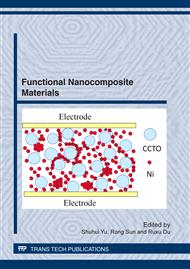[1]
X. Michalet, F. F. Pinaud, L. A. Bentolila, J. M. Tsay, S. Doose, J. J. Li, G. Sundaresan, A. M. Wu, S. S. Gambhir and S. Weiss: Science Vol. 307 (2005), p.538.
DOI: 10.1126/science.1104274
Google Scholar
[2]
J. Jang, J. Bae and E. Park: Adv. Functi. Mater. Vol. 16 (2006), p.1400.
Google Scholar
[3]
M. De, P. S. Ghosh and V. M. Rotello: Adv. Mater. Vol. 20 (2008), p.4225.
Google Scholar
[4]
J. H. Ho, L. Gu, G. von Maltzahn, E. Ruoslahti, S. N. Bhatia and M. J. Sailor: Nat. Mater. Vol. 8 (2009), p.331.
Google Scholar
[5]
P. Sharma, S. C. Brown, A. Singh, N. Iwakuma, G. Pyrgiotakis, V. Krishna, J. N. Knapik, K. Barr, B. M. Moudgil and S. R. Grobmyer: J. Mater. Chem. Vol. 20 (2010), p.8128.
DOI: 10.1039/c0jm00354a
Google Scholar
[6]
Z. A. Peng and X. G. Peng: J. Am. Chem. Soc. Vol. 123 (2001), p.183.
Google Scholar
[7]
K. G. Li, J. T. Chen, S. S. Bai, X. Wen, S. Y. Song, Q. Yu, J. Li and Y. Q. Wang: Toxicol in Vitro Vol. 23 (2009), p.1007.
Google Scholar
[8]
L. Y. Chen, C. L. Chen, R. N. Li, Y. Li and S. Q. Liu: Chem. Commum. Vol. 19 (2009), p.2670.
Google Scholar
[9]
A. M. Derfus, W. C. W. Chan and S. N. Bhatia: Nano Lett. Vol. 4 (2004), p.11.
Google Scholar
[10]
S. B. Park, J. O. You, H. Y. Park, S. J. Haam and W. S. Kim: Biomaterials Vol. 22 (2001) p.323.
Google Scholar
[11]
T. Suzuki, T. Matsumoto, Y. Hagino, in: Science and Technology of Polymers and Advanced Materials, edited by P. N. Prasad, J. E. Mark, S. H. Kandil, Z. H. Kafafi, Plenum, New York (1998).
Google Scholar
[12]
P. J. VandeVord, H. W. T. Matthew, S. P. DeSilva, L. Mayton, B. Wu and P. H. Wooley: J. Biomed. Mater. Res. Vol. 59 (2002), p.585.
DOI: 10.1002/jbm.1270
Google Scholar
[13]
R. A. Langer: Chem. Res. Vol. 94 (2000), p.94.
Google Scholar
[14]
J. Berger, M. Reist, J. M. Mayer, O. Felt, N. A. Peppas and R. Gurny: Euro. J. Pharm. Biopharm. Vol. 57 (2004), p.19.
Google Scholar
[15]
For example: L. Ma and C. S. Liu: Colloids Surf. B: Biointerf. Vol. 75 (2010), p.448.
Google Scholar
[16]
For example: A. CooperN. Bhattarai, F. M. Kievit, M. Rossoi and M. Zhang: Phys. Chem. Chem. Phys. Vol. 13 (2011), p.9969.
Google Scholar
[17]
J. M. Gong, X. L. Hu, K. W. Wong, Z. Zheng, L. Yang, W. M. Lau and R. Du: Adv. Mater. Vol. 20 (2008), p.2111.
Google Scholar
[18]
J. M. Gong, Z. J. Zhou, X. L. Hu, M. K. Wong, K. W. Wong and Z. L. Du: ACS Appl. Mater. Interfaces Vol. 1 (2009), p.26.
Google Scholar


